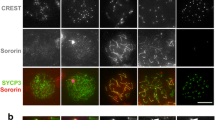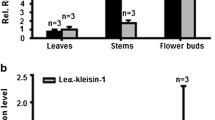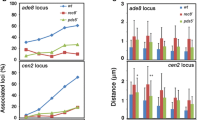Abstract
The meiotic behavior of a special maize trisome was quantitatively observed at pachytene, metaphase I, anaphase I, prophase II, metaphase II and anaphase II. The data obtained are consistent with (but do not prove) the model that sister chromatid cohesiveness at anaphase I may be established during pachytene synapsis of the chromosome regions involved. The data suggest, however, that the normal prophase II maintenance of dyad integrity by cohesiveness of sister chromatid centromere regions does not depend upon prior synapsis of these regions, although monads separated from each other on the anaphase I spindle may be delivered to the same prophase II daughter nucleus. — The strands which some of the time connect sister chromatids which are separating equationally at anaphase I show a positive Feulgen staining reaction.
Similar content being viewed by others
References
Einset, J.: Chromosome length in relation to transmission frequency of maize trisomes. Genetics 28, 349–364 (1943)
Gillies, C.B.: Ultrastructural analysis of maize pachytene karyotypes by three dimensional reconstruction of the synaptonemal complexes. Chromosoma (Berl.) 43, 145–176 (1973)
Gillies, C.B.: An ultrastructural analysis of chromosome pairing in maize. C.R. Lab. Carlsberg 40, 135–161 (1975)
Holm, P.B.: Three-dimensional reconstruction of chromosome pairing during the zygotene stage of meiosis in Lilium longiflorum (Thunb.). Carlsberg Res. Commun. 42, 103–151 (1977)
Luykx, P.: Kinetochore-to-pole connections during prometaphase of the meiotic divisions in Urechis eggs. Exp. Cell Res. 39, 658–668 (1965)
Maguire, M.P.: A study of pachytene chromosome pairing in a corn-Tripsacum hybrid derivative. Genetics 45, 651–664 (1960)
Maguire, M.P.: The relationship of crossover frequency to synaptic extent at pachytene in maize. Genetics 51, 23–40 (1965)
Maguire, M.P.: Non-random metaphasel orientation of the chromosomes of a trivalent. Genetica ('s-Gravenhage) 41, 361–368 (1970)
Maguire, M.P.: The effect of ethanol on meiotic chromosome behavior in maize. Caryologia (Firenze) 29, 41–47 (1976)
Maguire, M.P.: Homologous chromosome pairing. Phil. Trans. roy. Soc. Lond., B 277, 245–258 (1977)
Maguire, M.P.: A possible role for the synaptonemal complex in chiasma maintenance. Exp. Cell Res. 112, 297–308 (1978a)
Maguire, M.P.: Evidence for separate genetic control of crossing over and chiasma maintenance in maize. Chromosoma (Berl.) 65, 173–183 (1978b)
Sved, J.A.: Telomere attachment of chromosomes. Some genetical and cytological consequences. Genetics 53, 747–756 (1966)
Ting, Y.C.: Fine structure of the meiotic first prophase chromosomes in haploid and diploid maize. Genetics 61, s58 (1969)
Zickler, D.: Development of the synaptonemal complex and the “recombination nodules” during meiotic prophase in the seven bivalents of the fungus Sordaria macrospora. Chromosoma (Berl.) 61, 289–316 (1977)
Author information
Authors and Affiliations
Rights and permissions
About this article
Cite this article
Maguire, M.P. An indirect test for a role of the synaptonemal complex in the establishment of sister chromatid cohesiveness. Chromosoma 70, 313–321 (1979). https://doi.org/10.1007/BF00328769
Received:
Accepted:
Issue Date:
DOI: https://doi.org/10.1007/BF00328769




